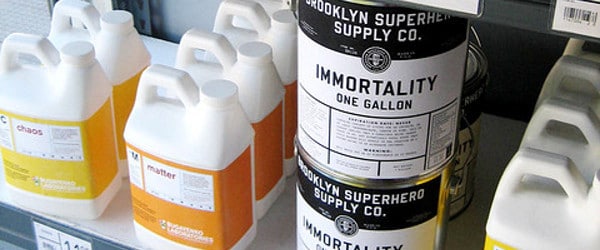Transfection of eukaryotic cells is a routine but sometimes tricky procedure. There are several transfection reagents available on the market, but sometimes the old methods are the best.
I find that the simplest, fastest and cheapest transfection method for eukaryotic cells is calcium phosphate mediated transfection (1). It’s main advantage is that, since Ca2+ is a small ion and part of the culture medium, cell viability is not a problem.
The exact mechanism of calcium phosphate mediated transfection is not known, but what we do know is that calcium, being poorly soluble in culture medium, forms microprecipitates in the presence of phosphate ions. These microprecipitates are believed to have a positive effect on transfection efficiency (2).
The reason for this is that when DNA is mixed with calcium phosphate microprecipitates, co-precipitates of DNA-calcium mixtures are formed. These strongly bind to the surface of the cell monolayer and enhance uptake of DNA by the cells (3) possibly by endocytosis.
The key to reproducible transfection efficiencies is to have a high concentration of calcium phosphate-DNA microprecipitates.
So how best to ensure you get this?
While calcium and phosphate ratios are important, other parameters such as reaction time, DNA concentration and temperature also play an important role in affecting calcium-phosphate mediated transfection.
Here I list the critical factors that can influence the formation of precipitate, and therefore the transfection, efficiency to a great extent based on a paper by Jordan, M et al, (4).
Transfection efficiencies as high as 60% can be obtained if care is taken with regards to the factors listed here.
1. DNA/Calcium reaction time: No more than 1 min.
Longer incubations can result in formation of fewer but larger precipitates that reduces transfection efficiency. This follows the simple concept that the larger particles have a hard time getting into cells. So, the precipitate particles should be small but very many.
This can be achieved by incubating cells with DNA/Calcium complex for no more than 1 min at standard concentrations of DNA and calcium phosphate (125mM of Calcium chloride, 0.77 mM of phosphate and 25ug/mL of DNA).
2. Concentration of components in the precipitation mixture:
DNA: 25ug/mL
Calcium: 125mM
Phosphate: 0.77mM.
Precipitation is crucial to this process. And of course, precipitates form when the dissolved substance is no longer soluble, so you have get the ratio of DNA:calcium phosphate right.
Higher concentrations of DNA can inhibit formation of precipitate while increasing concentrations of calcium could reverse the precipitation.
The formation of precipitate is significantly slower when phosphate concentration is reduced. Increasing the length of incubation to account for lower phosphate does not improve co-precipitation.
So stick to the ratios listed above for the best results.
3. Temperature: 23 C.
Small variation in temperature can affect the kinetics of DNA/Calcium co-precipitation complex.
At low temperatures, DNA does not co-precipitate with the calcium phosphate while at higher temperatures calcium phosphate solubility is reduced.
Osmotic shock by glycerol, DMSO or chloroquinone treatment can also be done to improve transfection efficiency. Nature Methods in association with Cold Spring Harbor Laboratory Press published a protocol for Calcium phosphate-mediated transfection of eukaryotic cells in their April 2005 issue (5) that follows the above recommendations.
So let’s put this into practice. Below is a quick protocol for adherent cells, although similar conditions should work for suspension cells too. In fact, since cells in suspension are in complete contact with the media, unlike adherent cells, transfection mix added to the media should allow faster DNA adsorption on cell surface. For more information on adapting this procedure for different cell types, reference 2 should come in handy.
So there is the basic protocol for calcium phosphate-DNA co precipitation:
1. Harvest cells by trypsinization and plate at required density. Change medium 1 hour before transfection.
2. Prepare calcium phosphate-DNA coprecipitate.
Prepare a solution of 100uL of 2.5M CaCl2 and 25ug of DNA diluted with 0.1x TE buffer (1mM Tris-HCl, 0.1mM EDTA, pH7.6) to a final volume of 1mL.
Add one volume of this 2x Ca/DNA solution quickly to an equal volume of 2x HEPES solution (140mM NaCl, 1.5mM Na2HPO4, 50mM HEPES, pH 7.05 at 23 C).
Mix two solutions quickly for 1 min and add 0.1mL of suspension to every 1mL of medium.
3. Incubate cells at 37 C for 2-6h.
4. Add pre-warmed complete growth medium and incubate for 1-6days.
5. Assay for transient expression of transfected DNA.
Good luck with your transfections. If you follow these tips and find them useful, or if you have any transfections tips of your own, please drop us a line in the comments section.
References:
1. https://www.nature.com/nmeth/journal/v2/n4/full/nmeth0405-318.html
2. Jordan, M & Wurm, F. Methods 33, 136-143 (2004).
3. Graham, F.L. & van der Eb, A.J. Virology 52, 456–467 (1973).
4. Jordan, M. et al. Nucleic Acids Res. 24, 596–601 (1996).
5. Nature Methods. 2(4), 319-320 (2005).







